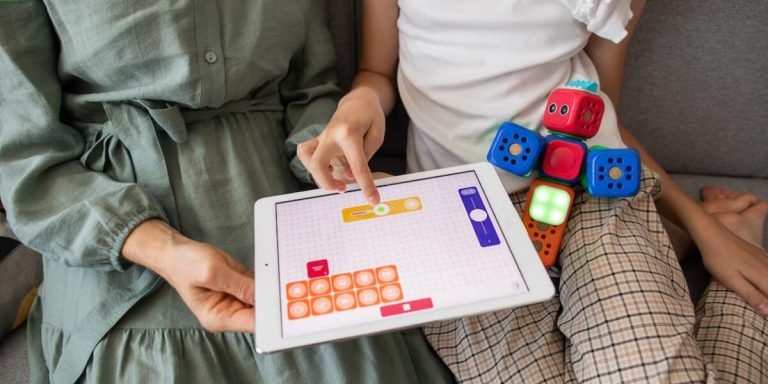What Does SPD Stand For in Early Childhood Education?
Navigating the world of early childhood education can sometimes feel like deciphering a complicated maze full of abbreviations and jargon, especially for special needs children. One term that frequently comes up when discussing this topic is SPD – but what does SPD stand for? This abbreviation refers to Sensory Processing Disorder, a condition that significantly influences learning processes and behavior in many young students.
Sensory Processing Disorder essentially affects how children perceive and respond to different sensory experiences. As parents or educators working with such youngsters, it’s crucial we expand our knowledge about these unique challenges since they are intricately linked with the kind of Special Education Resources and Support necessary for an effective educational journey. Our responsibility then extends beyond simply understanding ‘what does spd stand for’ as it also involves being knowledgeable enough to tailor supportive strategies accordingly.
Did you know?
The term SPD in early childhood education stands for Sensory Processing Disorder. It is a condition where the brain has trouble receiving and responding to information that comes in through the senses, dramatically affecting everyday learning tasks.
Understanding SPD: Clarifying the Basics of Sensory Processing Disorder
Sensory Processing Disorders, commonly known as SPDs, are a complex series of neurological disorders affecting both children and adults. They revolve around the way an individual’s nervous system receives messages from their senses and turns them into responses. Recognizing what does spd stand for in early childhood education refers to getting familiar with these challenges faced by some students in regular classroom settings.
SPDs manifest differently in every individual; they can affect one sense like hearing or touch, multiple senses simultaneously. A deep understanding of this disorder is crucial among educators today – it helps tailor special education resources and provide appropriate support that ensures effective learning experiences regardless of any sensory limitations present.
With continuous advancements in technology integration within the field of education, there have been promising strides forward overcoming obstacles posed by SPDs. Adaptable educational software tools offering personalized multisensory experiences serve as innovative solutions bridging gaps between conventional teaching methods which might not be optimal for those struggling with such conditions – acting as key facilitators enhancing interactive participation while making learning environments more inclusive.
Defining SPD: The Core Concept Explained
Sensory Processing Disorder, often abbreviated as SPD, is a condition that affects how the brain processes sensory information. But what does SPD stand for in detail? Let’s dive deeper.
Next is “processing”, which denotes how these sensed experiences are received by our brains and interpreted into responses or reactions. The processing part of SPD plays an essential role because it functions similarly to a sorting hub where all incoming sensory data gets organized before being sent off with appropriate actions associated with them.
The last element of this triad refers to “disorder”. In context of Sensory Processing Disorder itself implies that this intrinsic process has somehow become disorganized or dysfunctional resulting in difficulties interpreting sensory stimuli accurately.
Signs and Symptoms of Sensory Processing Disorder
Recognizing the signs and symptoms of Sensory Processing Disorder (SPD) can be a challenging task for parents, educators, as well as caregivers. But by understanding what SPD stands for and its key indicators, it becomes easier to identify if your child or student is facing this disorder.
Sensory Processing Disorder (SPD)
is a condition where the brain has difficulty receiving and responding to sensory information. Individuals with SPD may feel overwhelmed or under-stimulated by sounds, sights, smells, or touch.
Now that we understand SPD, let’s explore some common signs:
1. Oversensitivity: One key symptom includes oversensitivity towards different sensories like bright lights or loud noises where ordinary events can result in extraordinary reactions.
2. Undersensitivity: Conversely children might show less reaction than usual especially when exposed to pain; they sometimes engage in risky behaviors without realizing potential consequences.
3. Motor skill challenges: Children with SPD often exhibit poor motor skills reflected through lack of balance coordination leading to clumsiness or awkwardness during physical activities.
4. Difficulty engaging socially : They may have difficulty forming friendships due their discomfort around tactile experiences such as hugging shying away exhibiting extreme introvert behavior isolating themselves from other kids.
5.Information processing issues : Many struggle organize understand complex streams cognitive data becoming easily distracted thereby affecting academic performance school setting.
Navigating Special Education for Children with SPD
In the realm of special education, SPD stands for Sensory Processing Disorder. This condition greatly affects a child’s ability to respond appropriately to the sensory input they receive from their environment, such as touch or sound. It plays a significant role in childhood education as it can pose unique challenges both inside and outside educational settings.
Navigating the landscape of special education for children with SPD has been profoundly transformed by technology integration. In 2023, incorporating technology into instruction is no longer an option but rather an essential aspect influencing students’ learning capabilities. A number of resources and support systems have emerged that specifically cater to children experiencing SPD.
The use of adaptive technologies aiding audio-visual processing serves as one key intervention strategy in bridging the gap between typical developmental skills and those presented by kids diagnosed with this disorder.
Immersive experiences provided by virtual reality (VR), multimedia applications fostering real-world simulations are all part of today’s innovative tools educators employ when working with these young learners.
Moreover, integrating assistive tech devices into classroom curriculum also offers considerable benefits not only focused on academic accomplishments but social-emotional development too thereby moving beyond conventional teaching methodologies towards more inclusive ones understanding uniqueness lies at heart preparing our future society leaders.
Identifying Appropriate Resources for SPD Support
Sensory Processing Disorder, or SPD as it is commonly known, presents unique challenges when it comes to educating children. When we ask “what does spd stand for?”, the answer goes beyond a simple definition. It stands for kids who may struggle with handling sensory information such as touch, sound and movement.
In recent years digital technology has proven itself instrumental in education provision universally and more so in aiding specialized teaching approaches – meeting diverse needs including those presented by SPD.
Interactive educational software provides an engaging platform where children can learn at their own pace without feeling overwhelmed or overstimulated; they customize these platforms according to the child’s comfort levels making them enjoyable while being highly informative.
Simultaneously ‘Virtual Reality’ offers immersive experiences that cannot be replicated within traditional classroom settings; these seemingly real-life simulations allow students with SPD better comprehend lessons through visualized concepts reducing any anxiety linked traditionally structured classrooms might generate due its sensory overload inducing environment.
Specialized apps have also surfaced catering specifically towards helping parents navigate this unfamiliar terrain effortlessly – guiding them on how best assist their young ones throughout day-to-day activities improving overall quality life both child parent alike.
Finally online communities play major role supporting families dealing answering fully understand what does spd mean all aspects . They offer space share personal stories gain wisdom others similar situations bringing about sense connectedness removing feelings isolation often come facing such hurdles .
Creating an Effective IEP Tailored to Sensory Needs
In the quest to offer a fulfilling learning environment for each child, Sensory Processing Disorder (SPD) brings an added layer of complexity. The question on your mind might be – what does spd stand for? SPD is a condition where sensory signals are either not detected or don’t get organized into appropriate responses.
To effectively navigate this landscape in 2023 and beyond, we must create Individualized Education Programs (IEPs) that uniquely cater to kids with Sensory Processing Disorder (SPD). Technology integration in education can facilitate this process by:
1. **Digital Diagnostics**: Using AI-driven algorithms, software programs now exist which can do comprehensive diagnostics based on observational data from parents & teachers as well as test results.
2. **Tailored Learning Platforms**: Technology has paved way for personalized educational platforms designed specifically around special needs children including those dealing with SPD.
3. **Sensory Tools Integration**: With advanced equipment like weighted vests or specialized seating systems incorporating tech devices such as iPads etc., students can comfortably engage better within their school environments.
4. **Communication Apps** : Speech-generating apps help enhance communication skills while also building confidence among these youngsters by giving them more control over social interactions.
5.If needed online therapy: Leveraging teletherapy options so occupational therapists could work directly with the children over video calls further enhancing their abilities to manage daily tasks independently at home while boosting overall cognition levels too!
Strategies for Supporting Students With SPD in the Classroom
Successfully integrating students with Sensory Processing Disorder (SPD) in the classroom setting hinges on sophisticated strategies and well-informed understanding from educators. As many parents grapple, wondering “what does SPD stand for?”, it becomes unequivocally clear that there’s a demand for enhanced special education resources and support.
In 2023, technology plays an instrumental role towards this cause. With sensory processing disorder manifesting in various forms such as hypersensitivity or hyposensitivity to environmental inputs, tech tools are emerging as viable aids offering highly personalized learning experiences tailored to individual needs of every student afflicted by SPD.
As part of these progressive practices implemented within classrooms today, adaptive technologies like noise-canceling headphones can help minimize auditory distractions for those overly-sensitive to sound while educational apps foster interactive learning where tactile sensitivity is an issue. This multidimensional approach not only underscores what ‘SPD’ stands for but also how schools can bridge gaps between conventional teaching methods and the unique requirements posed by SPD.
At their core though, all efficacious strategies establish one fundamental truth: Understanding ‘what does SPD stand for?’ begins by acknowledging its intricacies which entails creating environments conducive enough facilitating full participation of children harboring this condition; ensuring no learner is left behind notwithstanding any neurological differences they may possess.
Incorporating Sensory Integration Techniques into Learning
Sensory Processing Disorder (SPD) can present unique challenges for students in the classroom. As educators and parents, understanding what SPD stands for is only part of this journey. Sensory integration techniques are essential when supporting these students.
Learning becomes a much more engaging process when we incorporate sensory-friendly strategies into our classrooms. This prioritizes not just cognitive but also physical learning experiences that cater to children with SPD – an approach that focuses on ‘learning by doing’.
A recent trend within special education resources and support involves incorporating technology as part of sensory integration methods. Digital tools have bridged gaps while creating innovative ways to make learning accessible for all learners regardless of their specific needs or abilities.
One such method includes using virtual reality games designed specifically for sensory engagement, like those available on platforms such as Oculus Rift or Google Cardboard. These technologies provide immersive experiences which help stimulate different senses simultaneously – aiding those who struggle with processing information from one sense at a time.
Interactive whiteboards are another useful tool allowing teachers to exhibit lessons visually — thus helping kids grasp new concepts via visual stimulants instead than relying solely upon auditory cues alone.
Adapting Curriculum and Classroom Environment for Sensitivity Concerns
Sensitivity concerns among students with Sensory Processing Disorder (SPD) can pose significant challenges in a traditional classroom setup. Therefore, the need for adapting curriculum and modifying the physical environment is a crucial aspect of optimizing student engagement and learning potential.
The first step towards successful adaptation involves recognizing what SPD stands for – ‘sensory processing disorder.’ It refers to a condition where the brain struggles to receive, respond to or sort sensory information like touch, sound or movement effectively.
Educators today navigate digital age classrooms by integrating technology, which benefits in creating environments that cater specifically to children with Sensory Processing Disorder (SPD). For instance:
1. Adopt Noise-cancelling Headphones: Excessive noise can be distracting for students struggling with auditory processing issues—a component of SPD. Using noise-canceling headphones during independent work times mitigates such distractions while allowing learners focus on tasks at hand better.
2. Use Interactive Whiteboards: Technology-based tools like interactive whiteboards could assist visual learners by making abstract concepts more concrete through illustrations and animations—aiding comprehension significantly.
3. Incorporate Assistive Learning Apps: Several apps designed exclusively for special education are available now–these not only make learning engaging but also facilitate personalized education based upon each child’s unique needs.
4.Investigate Virtual Reality Tools: VR Tech offers immersive experiences that help simulate situations which might be challenging otherwise – thus offering practical coping strategies within safe spaces.
Conclusion
As we have explored, “what does SPD stand for” is a common question among parents and educators dealing with early childhood education. This term refers to Sensory Processing Disorder, a condition where the brain has trouble processing sensory information leading potentially to challenges in learning and behavior. It’s an essential concept that takes understanding our children or students beyond just cognitive capabilities but also focuses on their interaction with their environment.
Never stop exploring other enlightening topics like this which help evolve your approach towards facilitating effective learning experiences for children. Our website offers rich resources designed specifically keeping you – the parent and educator – in mind offering support, guidance, advice and much more! Use it as a compass while navigating through your rewarding journey of shaping young minds into future leaders.







